Gary has been in touch with a system that uses a type of N scale modules:
“Hi Al: First of all, let me say THANKS for the years of tips, tricks and ideas emanating from your emails and other modeler’s creative thinking.
I have only been using N scale modules for about 5 years, including a year in Iraq (fortunate enough to have my own ‘hooch’) and four years in Japan, where my wonderful wife allowed me a whole bed room to model and run trains.
As is the experience of most modelers, I feel I have been blessed with improved modeling skills over the years and would like to share an idea I haven’t seen in print anywhere else, and that is the idea of ‘Platform Modeling’.
It is a simple and very easy to work with system, and I hope most would agree, comes out with pretty good result (see a couple of pictures I have sent along with this narrative).
Here is how it works:
After you have your track laid, you begin by outlining a template (on a piece of paper) of the area you want to model. I try to keep the templates for the platforms to a manageable size, as they need to be somewhat portable to move them from work space to layout and back again until you’re satisfied with it, and finally place it ‘permanently’ on your layout.
After the paper template is made, I use it to cut out a thin piece of styrene or sturdy cardboard. Cardboard box is NOT suitable (too thick). But I have a friend who keeps me well supplied with cardboard dividers (thin sheets used to separate dry goods for shipping in bigger boxes) and glue two of these together.
Using these cardboard sheets also facilitates easy wiring as poking a hole through the platform and taping the wires to the bottom is very easy to do.
And that’s about the end of the story, because once your cardboard platform is ready, all that is left is to scenic it, which can be done anywhere because of the portability – that’s the best part of these N scale modules.
Anyway, hope the pictures help explain, and thanks again for your postings. Please don’t quit.
Sincerely,
Gary”
Before –
Gary’s module reminded me of N scale modular layout.
“Al,
Happy to see you are drifting into the larger gauges. While I maintain an N gauge layout in my basement, I put on at least one display a year using Lionel Standard Gauge. It is part of a large display by the Bergen County Model Railroad Club. But dispatched ahead and attached are photos of a Standard Gauge setup being constructed slowly, a speed dictated by the fact it is 107 miles from my home and must be done on a time available basis.
Lionel Standard Gauge was produced from 1906 to 1939 and is 2 1/8” between the rails. It is a toy, thus, scale is not much of an issue. It is now back in production, but as reproductions of these ancient toys with more modern electronics including smoke and sound. It is all metal and thus, heavy, allowing it to make sufficient noise without help.
This layout is located in a large basement in rural Pennsylvania, USA. It was started for a friend who had built club display layouts with me for years. He passed away, having reached into his 90’s, last year, but this project continues to allow his family to enjoy his large collection of mostly antique trains, as they should be enjoyed, running and producing a tremendous amount of noise. Santa delivered his first train in the mid 1920’s.
The major issue faced in this location is that the ceiling is low and large ducts hang under that. I cannot stand up in most of the basement. Worse, the large air ducts hang over the layout were an eyesore. The solution was to cover them with clouds made of fire-proof pillow stuffing (Polly fiber).
The standard gauge operates on two loops, one a dog bone, going up and down 3% grade three levels. The second runs around the base rising only to reach a set of cross overs which connect the two lines. A storage yard is on a second table at right angles to the operating area. It is connected by a Y to the mountain line at mid-level. Above the standard line is an O gauge line which at one point goes though the clouds.
In these photos the locomotive is a reproduction by MTH of the classic Lionel 400. It is about 20 years old. The cars, however, all date from the 1920s. For years this train pulled by both reproductions and antiques, ran on the annual club display, built in three weeks each winter with an equal grade roaring up and down a hill with a train of 17-19 freight cars with a caboose.
Controlling antique locomotives, which use a pinion drive, on a hill is a major issue. They will take off when they go over the top. Some, shut off, would just role to the bottom of the hill. Thus, unless controlled by an operator who is never distracted, such layouts must be wired to two circuits one up and one down carefully set to avoid too much speed as it crosses the summit and starts down. Keeping heavy locomotives on the track is sort of important. This is not an issue with the reproductions.
John McHugh
Ho Ho Kus, NJ, USA”
Two fantastic posts today. A huge thank you to Gary for sharing his N scale modules and to and John too.
By the way, I don’t mind the larger scales at all – it’s just that not that many are sent in. So if you’re sitting on one, you know what to do.
And it doesn’t matter what scale takes your fancy either, there are more great tips and ideas in the guide. Have you taken the plunge yet? Why not give it a whirl and see what all the fuss is about.
Keep ’em coming folks.
Latest ebay cheet sheet is here (Thank you for all the comments).
Best
Al
PS More HO scale train layouts here if that’s your thing.
Need buildings for your layout? Have a look at the Silly Discount bundle.
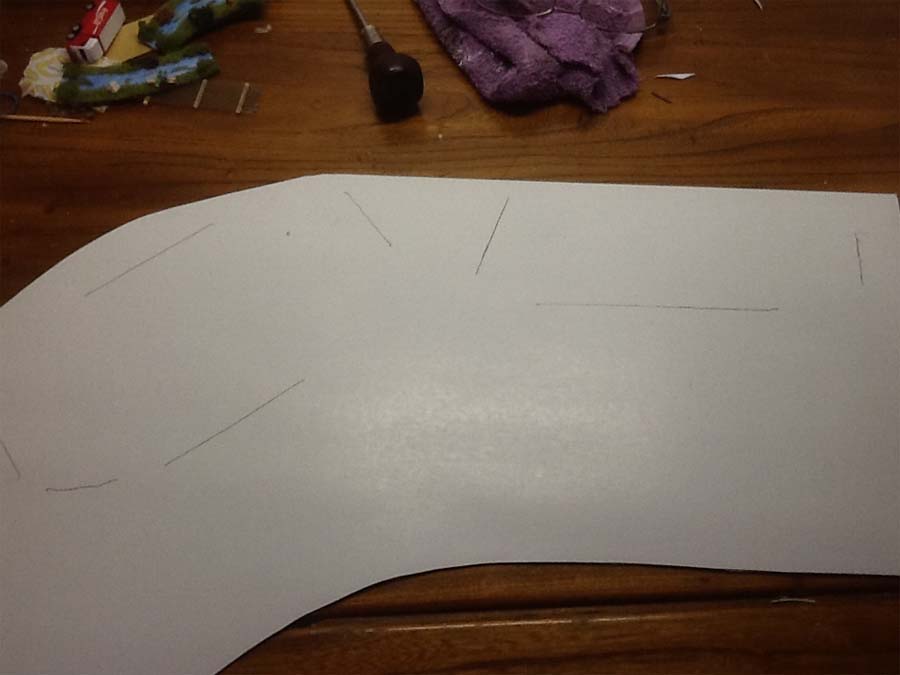
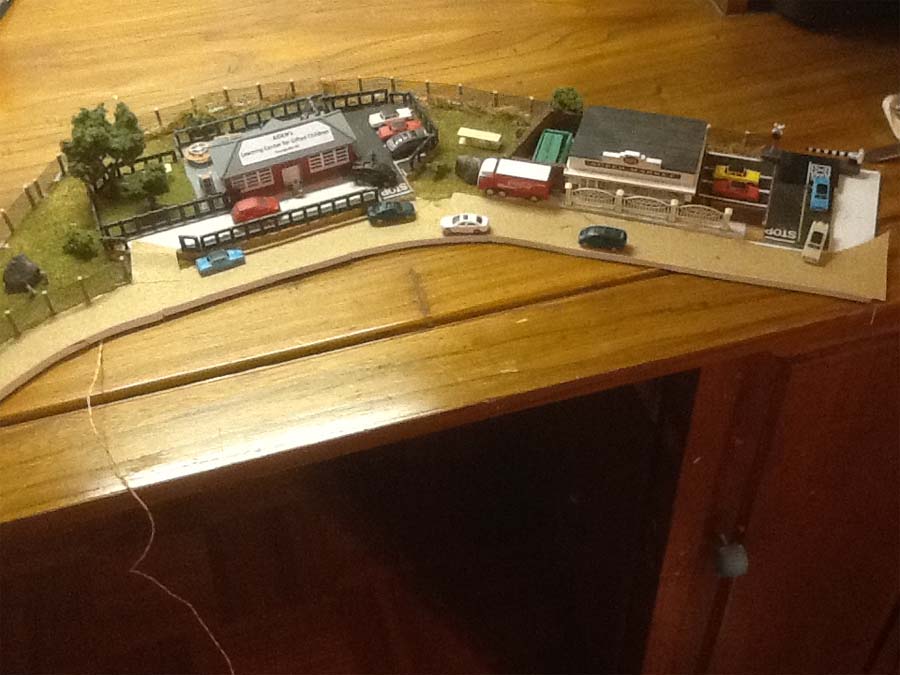
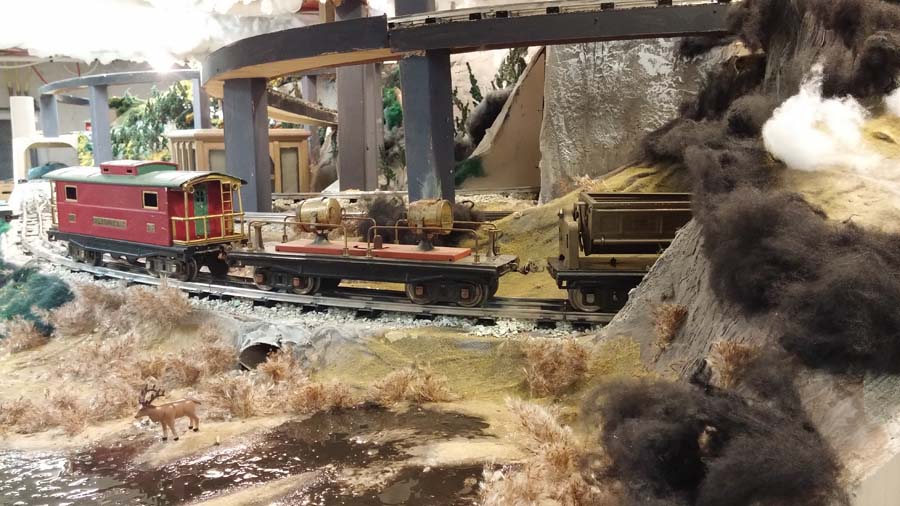
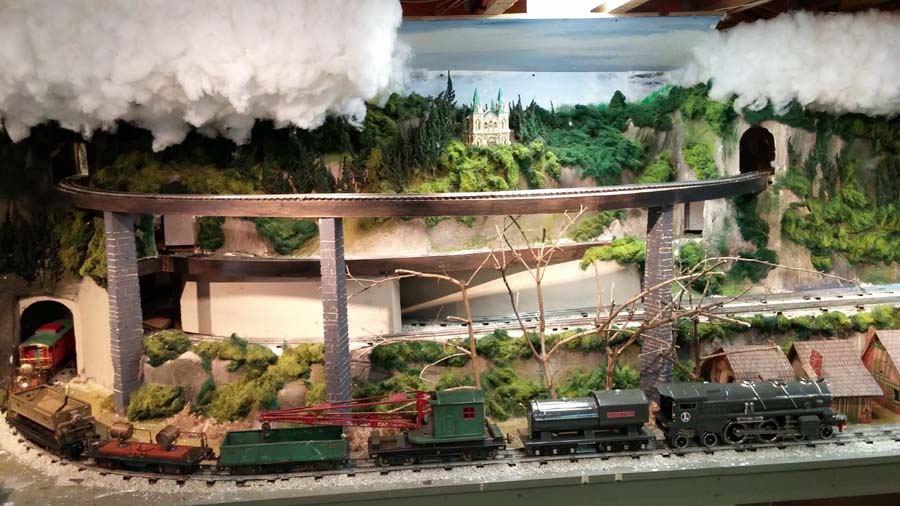
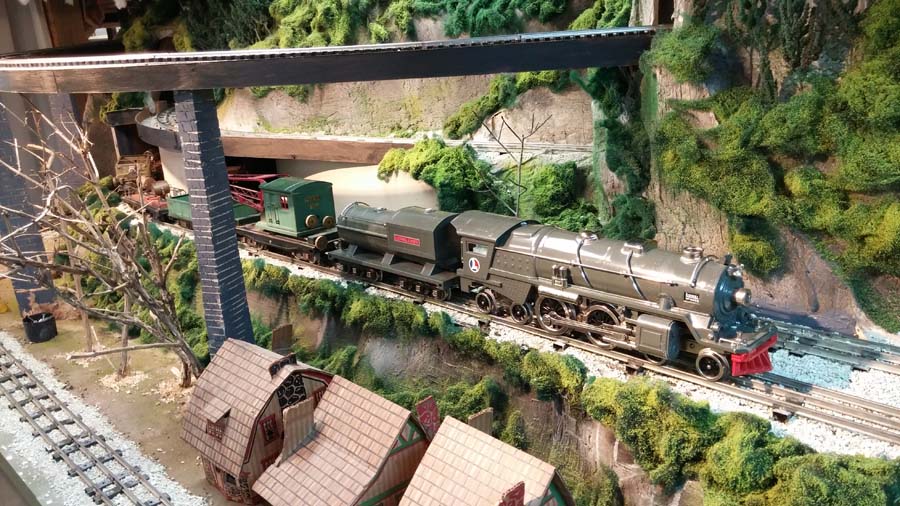
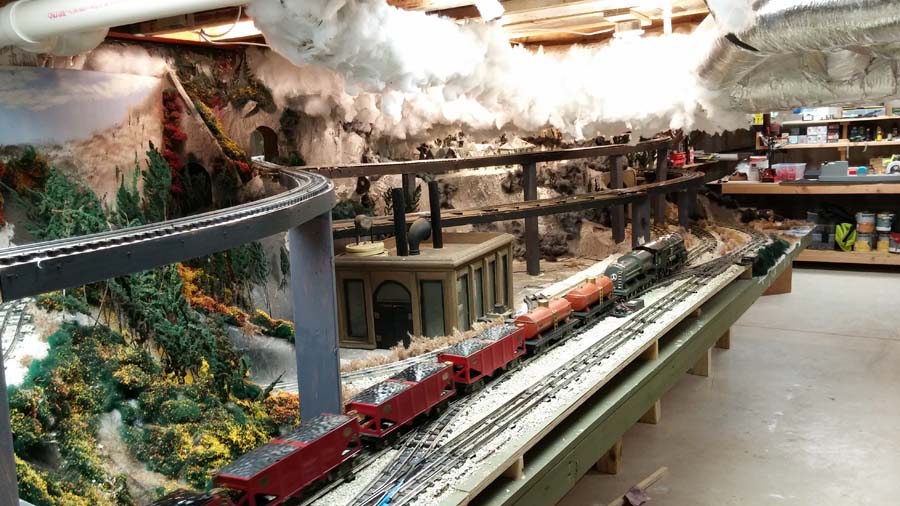
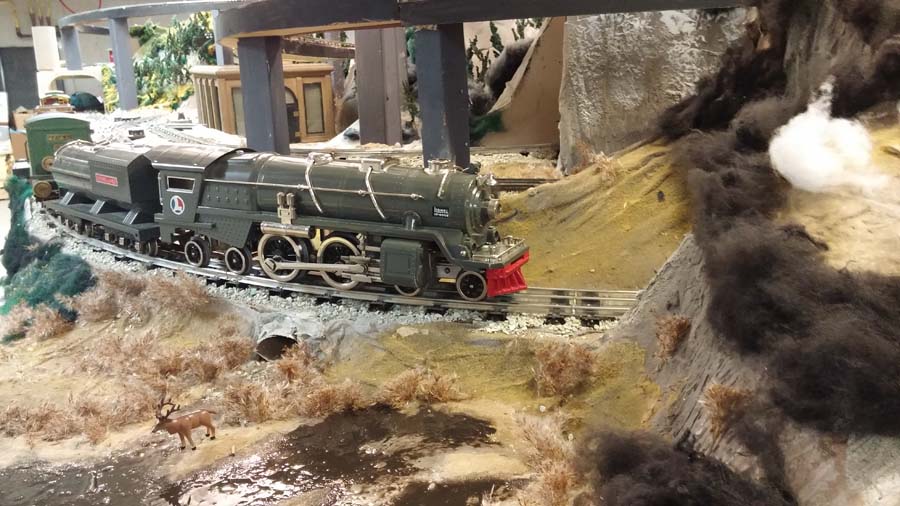
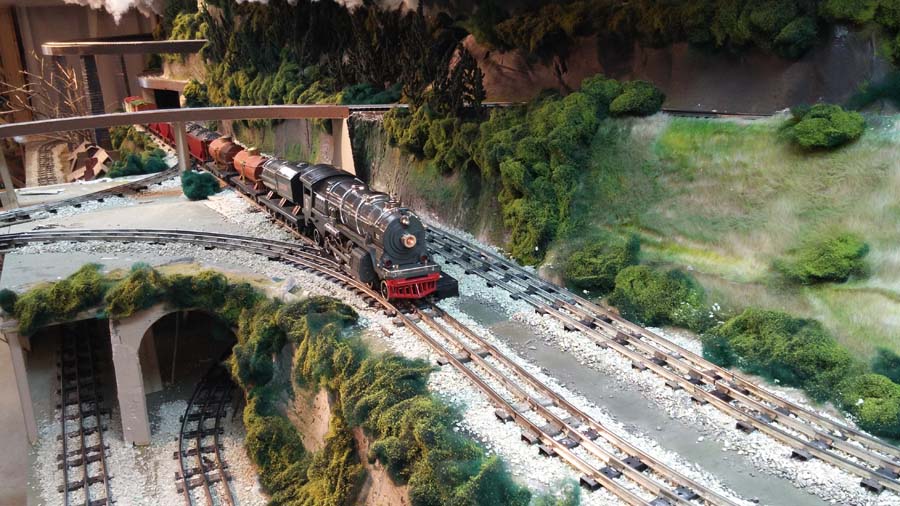

Well done you all, I,ve been n gauging for many years now and I STILL have,nt finished all the layouts (so far). S0o ntheres still time ,I,m 91 so I better get on with it!!. Withh all my very best r4gard sto ALOL in our hobby , Bernard
Good concept Gary. That’s definitely a nice way to model when portability is a major objective. All my buildings and cityscape in my layout is totally removable as well just to achieve this – good work. 🙂
Hi,
nice idea but a bit confusing at first for us simple Brits! A platform to us over here is something you get on and off the train from. A ‘scenic module’ would be a fancy way of saying it ☺ Not a bad idea though, do your modeling in comfort, I’m all for that.
Nice Lionel layout, I have a friend who has a Lionel 3-rail set up. Good idea with the clouds, though the weather must be a bit wet today as they are so low!
Mike S
Great idea for the removable scenery. I have a small N scale layout on the back of a door, since I live in an apartment. We will be moving sometime next year to a house…yeah!!! I have been putting off doing scenery and buildings due to budget but also due to the upcoming move. Now i can do what scenery and buildings I need and simply remove them when we get ready to move. Problem solved!!! Thanks Gary.
As for the O gauge layout. I have always been fascinated by the larger scale but have never gotten a set. I do love your layout and what a great way to honor your dearly departed friend in the process. Keep up the good work.
Take care and have a great day!!!!
James M
AL: Thanx for all your emails. I enjoy seeing what other modelers are doing around the world! I’m still working on my Marklin HO 4×8 foot layout. I ordered a new transformer to replace the original one that burned out. Hope to have it in another week.
Bud in, New Jersey, USA
wow I love Lionel and Marx trains
really nice ‘toy’ train layout…!!! LOL
had a great Marx layout of my own when I was a kid
and got into HO when I was a teenager
keep em runnin fellas!!
Awesome stories and outstanding pictures. Thanks for sharing Al. Love my HO Scale layout especially my four foot by sixteen foot rail yard. I will have to send pictures someday. Austin
When I saw the post about platforms I too was initially a little bemused. However, I do like the ideas set in the posting. I am very fortunate in that for the first time I have space for a layout which is permanent. One of the issues that I wrestled with was determining the height of the board above ground level. I prefer to be able to view the the scene from just slightly below ground level rather than an aerial perspective. So the boards are set at 1.3m (54″) height and the depth is 600mm (24″) in width. This invariably means that in some areas access requires steps to undertake work, particularly where the station buildings and platform are located so using your approach offers a different way of resolving this problem.
Thank you for your ideas which are applicable with some modification to accommodate the larger scales.
Jerry (UK)
great pictures they gave me some ideas for when I build my elevated track like hearing stories on people who have been building layouts for years I am new to railway modelling so this site give me so much pleasure. love the idea templating a place on your layout and go somewhere else to build .my layout is in the shed. so I could build my buildings in my work office .
That is the best Standard gauge layout I have ever seen–and I’ve seen a lot of them. The balance between reality and fantasy which you have struck is absolutely spot on.
Also, Bravo for the N scale insight, and thank you for your tip(s) and your service.–Tom
Can I run dc with dcc
Hi Al, I do love American engines.
would like to stay in your loop for std.ga. trains. thanks, harry
I have attended the Bergen County Model Railroad clubs annual Christmas displays over the years. They are truly wonderful. Are they still in that little building in the Ramsey shopping center off Rt.17? I used to live in Wyckoff some 23 years ago. Then I moved to Bethlehem when I retired from Hawthorn high School.
The standard gauge layout is also spectacular. I wonder if one could schedule a list to see this layout in person and enjoy some train stories.? Great posts and hope to see more.
If you keep your scenic modules (platforms) able to be removed from the layout, you can have a layout that can change its period (old-timer, steam, modern, etc) but it’s a trick to hide the joins!
Where are all the S guage American Flyer guys don’t ever see any here
I am an S gauge fanatic, and i’m building a layout out of 96 x 60 inch plywood. I’d love to hear from other people who love the perfect size (attribution from the guy Marshall McClintock who wrote How To Build and Operate a Model Railroad).
I have no other problems with other gauge be z, n, HO, O or G, I have no problems the authors of the blog, I just enjoy S since i was a child of age 6 when i received my American Flyer set. No that I’m 75 years old, my hand are stiff from older age. I appreciate the beauty of the other sizes. Howard Schultz from Tamarac, Fl
ho
Great idea Gary. I guess that I could say that my “Making Tall Grass” post was a form of Platform modeling .I found it much easier to sit at my work bench, which is stool height. It’s actually a clock/ watch makers bench. The small drawers running down the side are great for organizing modeling tools..
Bob in Colts Neck Crossing, NJ
Hi Gary,
I surely see the benefits of you platform idea.
My only question is how do you blend this platform into the rest of the layout once it is ready? How do you let the edges of the platform disappear?
Kind regards,
Ruud
John. Great that you and your friends keep this Lionel layout running. Well done
Iain Rice in his layout planning books uses something like the ‘platform’ technique to Mount sections of scenery, sometimes including track, onto main baseboard structures so the sections cab be irregular shapes, allowing their edges to be sited wherever the plan provides suitable scenic features to disguise the section edges.
John very nice layout well done, Have you ever been on OGR https://ogrforum.ogaugerr.com, If not check it out. (OGRsitka,member)
Very nice, excellent job! I’m in T-Trak N scale so I can break down and setup quickly. Jim L. now from Fla.
Gary, When I first read your post, I misunderstood what “platforms: you were talking about. I assumed you meant station platforms and not layout sections. Thank goodness your photos eventually revealed the true nature of your post and I like the idea. I just finished reading Pelle Soeborg’s book on building a sectional model railroad layout and your method would work well in that context.
John, I loved your photos of the Lionel standard gauge layout and rolling stock. Thanks for sharing the photos and, especially, the story of the layout.
Pretty Neat.!!!
Great Modelling Gary. I have seen versions of the ‘Platform’ method used in earlier posts on Alistair’s Blog. If I recall correctly Ben (Olsen’s Farm etc.) showed how he did his and it is a very good tip. You can manipulate the ‘Platform’ to see and work from all angles more easily than when modelling directly on a base board. Also any construction mess is kept away from track work and other sensitive parts of the layout. As others have commented thought has to be given when it comes to hiding the joins after the ‘platform’ is placed on the layout. For me hedges and bushes are the most common.
Andrew in Oz
Great idea on the platforms. As an alternative to the cardboard, I create all my buildings including platforms using the off-cuts from the picture framers. It is a sturdy card which cuts and shapes easily with a craft knife, takes to a variety of glues rather well and as it is 1mm thick, with me modelling in OO gauge, it equates to 3″ in prototype. I have also found that with downloading photographs of buildings from the internet, sizing them to the right scale, printing them on normal paper and pasting to the card works really well. I guess we all find our own innovative solutions which just makes this hobby so fantastic. Well done on your project.
THANK YOU, GARY!
I model in HO and include “HO” road race set city streets. Granted the vehicles are closer to “S” scale. This is a situation that rubs me the wrong way, but I got started with the idea as an early teen (Which was 60+ years ago.) and this is the first layout I’ve actually tried to fulfill that dream on.
With all that said I have city “blocks” for my urban areas that are roughly 1/4″ below street level. You’ve inspired me to make lift out inserts/platforms to resolve my elevation issues an make it easier to do detailing work at the bench. I just need to clear the usual clutter and make room now. 👏
very nice
How big is the O scale layout? It looks huge with so many rails.
Will go directly to the “O” display (other has good ideas also). Now this is priceless, with the billowing overcast and those bridges are terrific, no joke. Actually makes the train look toyish it’s all done so well.
Regarding, R
To Roger Clark…
I would love to see pics of your layout, as I am gathering ideas for putting together mine, now that I am semi-retired! I have been an Aurora slotcar and HO train guy for 60+ years now, and would like to finally build something to incorporate the two, with probably a bit more emphasis on the slotcar portion (but we’ll see how that may change along the way!)
Thanks for any input, greatly appreciated!
the tall bridges are wonderful & as is the whole setup
Gary,
I like your module. I think you’ve done a nice job on it. I look forward to seeing more of them. But I hate to tell you that idea has been around for a long time. There were examples in the Model Railroader magazine since at least the early 1960’s. However, they were built on plywood and later on high-density insulation foam, not styrene, or cardboard. That part is new. Keep up the good work.
Alastair, you do such wonderful work in promoting the hobby I’m sorry to hear you are being taken advantage of.
Scrap-metal loads for N or HO — I’m salvaging those metal staples from large shipping boxes from online vendors – they make great scrap-metal loads – just use a pliers to straighten them a bit.